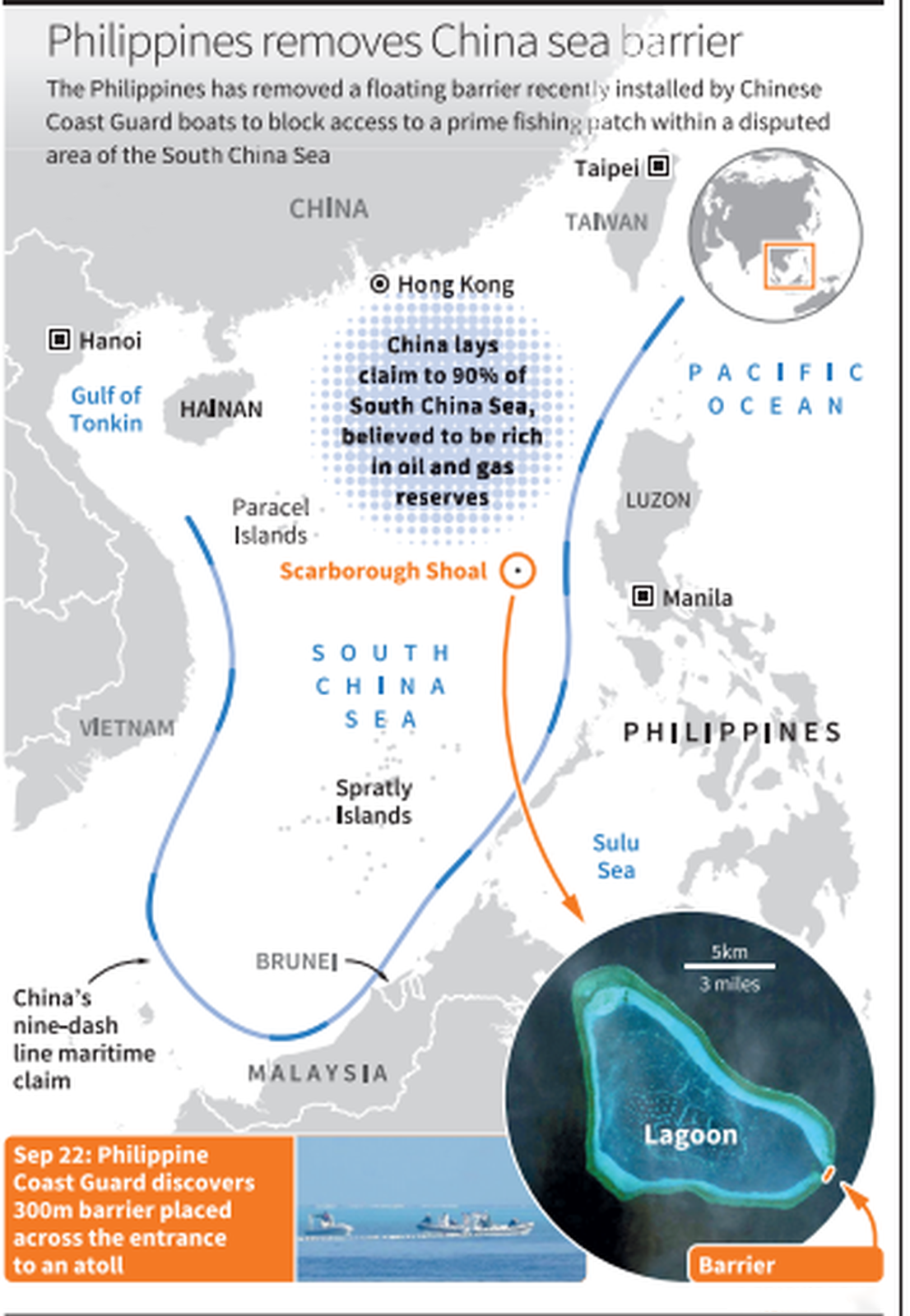South China Sea | 05 Oct 2023
For Prelims: South China Sea, Spratly Islands, Paracel Islands, Pratas, the Natuna Islands and Scarborough Shoal, ASEAN, UN Convention on the Law of the Sea
For Mains: Significance of the South China Sea and Related Issues
Why in News?
Recently, the Philippines Coast Guard removed barriers placed by Chinese vessels at the entrance to a lagoon off the Scarborough Shoal.
- This incident came after Chinese Coast Guard ships placed a 300-meter-long barrier to prevent boats from the Philippines from entering, adding to the long-running tensions in the South China Sea.
What is the Significance of the South China Sea?
- Strategic Location: The South China Sea is bordered by China and Taiwan to the north, the Indo-Chinese peninsula (including Vietnam, Thailand, Malaysia, and Singapore) to the west, Indonesia and Brunei to the south, and the Philippines to the east (referred to as the West Philippine Sea).
- It is connected by the Taiwan Strait with the East China Sea and by the Luzon Strait with the Philippine Sea (both marginal seas of the Pacific Ocean).
- Trade Importance: Approximately USD 3.37 trillion worth of trade passed through the South China Sea in 2016, making it a crucial global trade route.
- According to the Center for Strategic and International Studies (CSIS), 80% of global trade by volume and 70% by value is transported by sea, with 60% of it passing through Asia and one-third of global shipping moving through the South China Sea.
- China, the world's second-largest economy, relies heavily on the South China Sea, with an estimated 64% of its trade passing through the region. In contrast, only 14% of U.S. trade traverses these waters.
- India relies on the region for approximately 55% of its trade.
- Fishing Ground: The South China Sea is also a rich fishing ground, providing a vital source of livelihood and food security for millions of people in the region.
What are the Major Disputes in the South China Sea?
- Dispute:
- The heart of the South China Sea dispute revolves around territorial claims to land features (islands and reefs) and their associated territorial waters.
- The major island and reef formations in the South China Sea are the Spratly Islands, Paracel Islands, Pratas, the Natuna Islands and Scarborough Shoal.
- As many as 70 disputed reefs and islets are under contention, with China, Vietnam, the Philippines, Malaysia, and Taiwan all building more than 90 outposts on these disputed features.
- China claims up to 90% of the sea with its "nine-dash line" map and has physically expanded islands and constructed military installations to assert control.
- China has been particularly active in the Paracel and Spratly Islands, engaging in extensive dredging and artificial island-building, creating 3,200 acres of new land since 2013.
- China also controls the Scarborough Shoal through a constant Coast Guard presence.
- The heart of the South China Sea dispute revolves around territorial claims to land features (islands and reefs) and their associated territorial waters.
- Efforts to Resolve the Dispute:
- Code of Conduct (CoC): Talks between China and the Association of Southeast Asian Nations (ASEAN) have aimed at establishing a CoC to manage the situation, but progress has been slow due to internal ASEAN disputes and the magnitude of China's claims.
- Declaration on the Conduct of Parties (DoC): In 2002, ASEAN and China adopted the DoC, affirming their commitment to peaceful dispute resolution in accordance with international law.
- The DoC was meant to pave the way for a CoC, which remains elusive.
- Arbitral Proceedings: In 2013, the Philippines initiated arbitral proceedings against China under the UN Convention on the Law of the Sea (UNCLOS).
- In 2016, the Permanent Court of Arbitration (PCA) ruled against China's "nine-dash line" claim, stating it was inconsistent with UNCLOS.
- China rejected the arbitration ruling and asserted its sovereignty and historical rights, challenging the PCA's authority.
Note
Under the UNCLOS, each state can establish a territorial sea of up to 12 nautical miles and an Exclusive Economic Zone (EEZ) extending up to 200 nautical miles from the territorial sea baseline.
Way Forward
- Multilateral Engagement: Encourage active involvement from the international community, including countries outside the region, to facilitate diplomatic efforts and ensure that any resolution is fair, impartial, and in line with international norms particularly the United Nations Convention on the Law of the Sea.
- Environmental Protection: There is need for collaboration on efforts to protect the marine environment in the South China Sea, including measures to combat illegal fishing, reduce pollution, and preserve biodiversity because the total fish stocks in this region have been depleted by 70 to 95% since the 1950s and coral reefs, have been declining by 16% per decade, according to a report from the Center for Strategic and International Studies.
- Maritime Peace Parks: Explore the concept of creating maritime peace parks or protected areas within the South China Sea. Similar to terrestrial national parks, these areas could be designated for peaceful purposes, such as conservation, research, and ecotourism, transcending political disputes.
UPSC Civil Services Examination, Previous year Question (PYQ)
Mains
Q. Evaluate the economic and strategic dimensions of India’s Look East Policy in the context of the post-Cold War international scenario. (2016)

